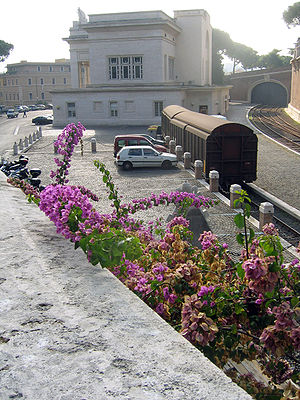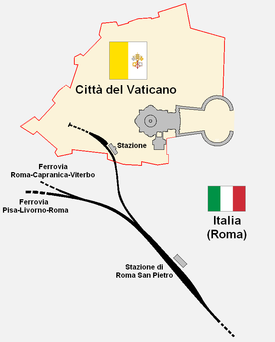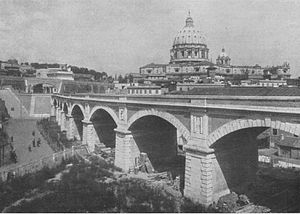- Rail transport in Vatican City
-
Vatican Railway
Ferrovia Vaticana
Vatican City railway stationOverview System Holy See railway Status Operational Locale Vatican City and Italy Termini Roma San Pietro
41°53′47″N 12°27′16″E / 41.896302°N 12.454533°E
Vatican City
41°54′04″N 12°27′04″E / 41.901014°N 12.451181°EStations 2 Operation Opened 1934 Owner Holy See Operator(s) Ferrovie dello Stato Technical Line length 1.27 kilometres (0.79 mi) No. of tracks One Track gauge Standard Gauge
1,435 mm (4 ft 8 1⁄2 in)Electrification no Route map Legend


to Roma Ostiense and Roma Termini 


Roma San Pietro 


to Pisa and Viterbo 


Viaduct on Via Aurelia 





state border 


Città del Vaticano 





Load tracks 





Headshunt in tunnel 


Rail transport in Vatican City consists of two 300-metre sets of rail tracks within Vatican City (named Vatican Railway, Ferrovia Vaticana), the shortest national railway system in the world, with only one station.[1] Access to Italian rail lines was guaranteed by the Lateran Treaty (1929), and tracks and station were constructed during the reign of Pope Pius XI. The only station is referred to as Vatican City (officially: Città del Vaticano, also named Stazione Vaticana).
Most railway traffic consists of freight good importation, although the railway has occasionally carried passengers, usually for symbolic or ceremonial reasons.[2][3]
Contents
History
Pope Gregory XVI (died 1846) prevented the construction of railways in the Papal States, and was reputed to have said "chemin de fer, chemin d'enfer" ("road of iron, road of hell").[4] Gregory XVI's successor, Pope Pius IX, began the construction of a rail line from Bologna to Ancona but the territory was seized by the armies of the Risorgimento in 1861 before it was completed.[5] The utility of rail travel for the mass pilgrimages of the 19th century, beginning with those at Lourdes circa 1858, was one factor that softened opposition to such technology within the Roman Curia.[6]
The construction of a railway station in Vatican City and its linkage to the Italian rail lines was guaranteed by the Lateran Treaty of February 11, 1929. The Directorate of New Railway Construction of the Ministry of Public Works of the Kingdom of Italy implemented this provision with construction beginning on April 3, 1929, to establish earthworks 38 m above sea level (the height of the "Roma - San Pietro" station) between Piazza Santa Marta and the Palazzo del Governatorato.[7] The construction of the viaduct leading to Vatican City was paid for by the Italian government; the station within the Vatican was financed from the ₤750 million indemnity agreed to in the Lateran Treaty's financial part.[8] The total cost of construction was reported to be ₤24 million.[9]
The Vatican Railway Station (later split into a Goods Office and numismatic and philatelic museum) was built approximately 20 m from the Entrance Gateway by architect Giuseppe Momo.[7] Construction began on April 3, 1929, and the station began operation in 1933.[7] Its simple white, Italian marble design was described by writer H. V. Morton as "more like a branch of the Barclay Bank in London."[1] The station building is composed of white marble, and its dimensions are 61 x 21.5 m. The central body is 16.85 m tall and the lateral ones 5.95 m.[10]
The first locomotive entered the Vatican in March 1932. The station was opened officially on October 2, 1934.[11] A Railway Convention was ratified between Italy and Vatican City on September 12, 1934, on which date the property passed from Ferrovie dello Stato (Italian State Railways) to the Holy See.[7] In October 1934 the Ministry of Public Works gave the completed rail lines to Vatican City and Ferrovie dello Stato, respectively.[7] Legge sulle fonti del diritto (June 7, 1929) made Italian railway legislation binding on Vatican-controlled railways.[7]
In late March 1944, during the allied bombing of Rome in World War II, the Vatican discovered a German munitions train stopped on the line by the Vatican railway station.[12]
Route
The Vatican City State Railway branches off from the Rome to Viterbo railway line at the "Roma San Pietro railway station" and crosses Gelsomino valley via a 143.12 metre long masonry viaduct of eight 15.30 metre arches (bearing the Fasces and the Savoy Coat of Arms), which crosses Viale Vaticano (which it interrupts) and Via Aurelia. The Via delle Cave and the Via del Gelsomino are also interrupted by the viaduct and thus merge with the Via Aurelia.[7]Before passing through the Vatican City walls and terminating in the Vatican City railway station, the line passes under an arch decorated with the Coat of Arms of Pope Pius XI with a sliding two-piece 35.5 ton iron gate which slides into the recesses of the Vatican walls.[1][7][13] The gate is closed when there is no traffic scheduled on the line.
The station counts two tracks (partly located in Rome, outside the gateway), but only the first is served by a platform. Two terminal load tracks, for freight wagons, are situated in northerst side of the building. They are linked to the main track that ends in a headshunt on a tunnel.
The station is located close to Vatican Gardens, behind St. Peter's Basilica. The gateway separating the station from rail track in Italian territory is part of Leonine Wall. Other relevant buildings located close to the station are the Governatorate Palace and the Domus Sanctae Marthae.
Uses
The Vatican railway has been used primarily for importing goods (before automobile travel became more common and less expensive) into the Vatican and intermittently for ordinary passenger trains.[14]
The planned papal train of Pius XI was never constructed and the Vatican has never employed any railway workers or registered any rolling stock.[7] The official train of Pope Pius IX remains on display at the Museum of Rome in the Palazzo Braschi.[5]
Pope John XXIII, on October 4, 1962, became the first pope to use the Vatican railway during his pilgrimage to Loreto and Assisi one week before the beginning of Second Vatican Council using the Italian presidential train; the trip was broadcast on the Eurovision Network. Pope Pius IX had been both the last pope to visit Loreto (as the head of the Papal States) and the last pope to travel by train.[5] John XXIII also arranged for the remains of Pope Pius X to be transferred to Venice using the Vatican railway.[7]
Pope John Paul II used the railway a few times for symbolic purposes, as early as November 8, 1979, but did not use the railway to leave Rome until January 24, 2002.[7]
The present Pope Benedict XVI uses the railway as well, e.g. for a pilgrimage to Assisi (October 27, 2011).[15]
Vatican City station has no regular passenger trains scheduled.
Gallery
-
An FS freight car in Vatican station
See also
References
- ^ a b c Korn, Frank J. 2000. A Catholic's Guide to Rome: Discovering the Soul of the Eternal City. Paulist Press. ISBN 0-8091-3926-X. p. 49.
- ^ Walsh, Michael J. 2005. Roman Catholicism: The Basics. Routledge. ISBN 0-415-26380-8. p. 95.
- ^ Garwood, Duncan. 2006. Rome. Lonely Planet. ISBN 1-74059-710-9. p. 141.
- ^ Pollard, John. 2005. Money and the Rise of the Modern Papacy. ISBN 0-521-81204-6. p. 29.
- ^ a b c Prusak, Bernard P. 2004. The Church Unfinished: Ecclesiology Through the Centuries. Paulist Press. ISBN 0-8091-4286-4. p. 271.
- ^ Alberigo, Giuseppe, and Komonchak, Joseph A. 2003. History of Vatican II. Peeters Publishers. ISBN 90-6831-724-5. p. 76.
- ^ a b c d e f g h i j k Holy See Press Office. 28 January 2001. Trans. Glyn Williams. "The Vatican City State Railway."
- ^ Reese, Thomas J. 1996. Inside the Vatican: The Politics and Organization of the Catholic Church. Harvard University Press. ISBN 0-674-93261-7. p. 203.
- ^ Anon. 1934. The Vatican Railway. Railway Magazine. 75 (449: Nov.), p. 352 & 369.
- ^ (Italian) Infos about the building on www.vatican.va
- ^ Infos about the station on www.vatican.va (Italian)
- ^ Chadwick, Owen. 1988. Britain and the Vatican During the Second World War. Cambridge University Press. ISBN 0-521-36825-1. p. 285.
- ^ (Italian) Infos about the gateway on www.vatican.va
- ^ (Italian) Infos about the traffic on www.vatican.va
- ^ The Vatican Railway Station: off to Assisi, Vatican Radio, 2011-11-26
External links
 Media related to Vatican City railway station at Wikimedia Commons
Media related to Vatican City railway station at Wikimedia CommonsRail transport in Europe Sovereign
states- Albania
- Andorra
- Armenia
- Austria
- Azerbaijan
- Belarus
- Belgium
- Bosnia and Herzegovina
- Bulgaria
- Croatia
- Cyprus
- Czech Republic
- Denmark
- Estonia
- Finland
- France
- Georgia
- Germany
- Greece
- Hungary
- Iceland
- Ireland
- Italy
- Kazakhstan
- Latvia
- Liechtenstein
- Lithuania
- Luxembourg
- Macedonia
- Malta
- Moldova
- Monaco
- Montenegro
- Netherlands
- Norway
- Poland
- Portugal
- Romania
- Russia
- San Marino
- Serbia
- Slovakia
- Slovenia
- Spain
- Sweden
- Switzerland
- Turkey
- Ukraine
- United Kingdom
- Vatican City
States with limited
recognition- Abkhazia
- Kosovo
- Nagorno-Karabakh
- Northern Cyprus
- South Ossetia
- Transnistria
Dependencies
and other territories- Åland
- Faroe Islands
- Gibraltar
- Guernsey
- Jan Mayen
- Jersey
- Isle of Man
- Svalbard
Other entities  Main railway stations in Rome
Main railway stations in RomeES/IC stops Roma Ostiense • Roma Termini • Roma TiburtinaOther stations Roma San Pietro • Roma Trastevere • Roma Tuscolana • Vatican City (in Vatican territory)Railway stations in Europe Albania • Andorra • Armenia1 • Austria • Azerbaijan1 • Belarus • Belgium • Bosnia-Herzegovina • Bulgaria • Croatia • Cyprus1 • Czech Republic • Denmark • Estonia • Faroe Islands2 • Finland • France • Georgia1 • Germany • Gibraltar2 • Greece • Hungary • Iceland • Ireland • Italy • Kazakhstan1 • Kosovo3 • Latvia • Liecthenstein • Lithuania • Luxembourg • Macedonia • Malta • Moldova • Monaco • Montenegro • Netherlands • Norway • Poland • Portugal • Romania • Russia1 • San Marino • Serbia • Slovakia • Slovenia • Spain • Sweden • Switzerland • Turkey1 • Ukraine • United Kingdom (England, Northern Ireland, Scotland, Wales) • Vatican City1 Partly in Asia. 2 Dependencies. 3 Status undetermined.Categories:- Rail transport in Vatican City
- Viaducts
- Railway lines in Italy
- Transport in Rome
- Railway stations in Rome
Wikimedia Foundation. 2010.












